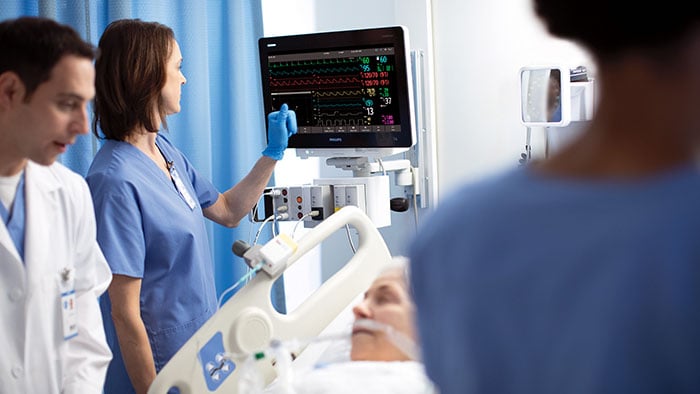Digital technology and the use of data are transforming every aspect of human life, and there are no signs of this trend slowing down anytime soon.
Momentum has been building over a long period of time, stretching all the way back to 1947 and the invention of the transistor – in essence the data transfer device underpinning the whole of digital technology. Skip through the following decades, and add in the launch of the first personal computer, the first mobile phone, the internet, 5G connectivity, and you have an ever-growing avalanche of data. According to Statista 2021, the total amount of global data is forecast to continue increasing rapidly, with a massive 90-fold growth projected from 2010 to 2025.
Digital and healthcare
Digitalization is also a key trend in healthcare, touching almost every facet and opening up new opportunities for the delivery of care. We have already seen a huge step-up in adoption of digital technology, especially post-COVID, as health-conscious consumers and capacity-stressed health systems turn to technology to help them address their challenges.
Also for those 3.5 billon people around the world who do not have access to healthcare today, digitalization holds the key to radical improvement in their lifetime, as digital solutions are intrinsically much more scalable, and thus support wider prevention, better triage, and lower cost per treatment.
Today, Philips is already very much a digital company, with 1 in 2 of our R&D employees working in software development and data science. By integrating data, we are able to create smarter, connected health solutions. Applying clinical decision algorithms and predictive analytics, for example, we can use data to deliver personalized, actionable insights. For instance, to motivate healthy behavior through digital coaching, or to alert medical teams to potential problems.
We believe that digitalization can accelerate the adoption of much-needed sustainable models of healthcare, including wider access to care, e.g. by enabling underserved communities to 'leapfrog' the gap in provision of primary services.
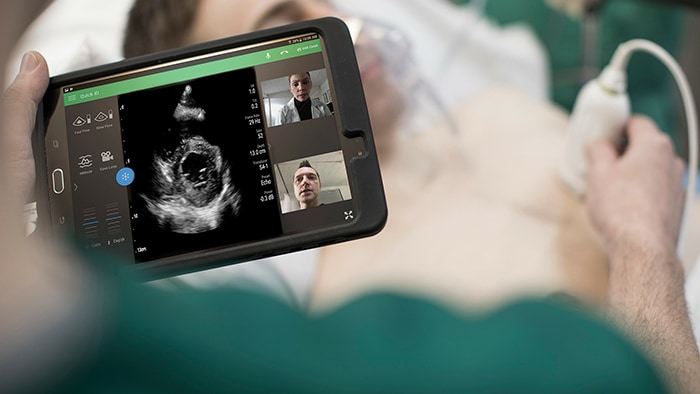
The link to environmental sustainability
Having said that, making healthcare accessible to all of mankind cannot, must not, imply a doubling of healthcare’s global environmental footprint, which is already horrendous. If healthcare were a country, it would be the 5th-largest emitter globally, accounting for more than aviation or the shipping industry.
Digitalization can help reduce healthcare’s environmental footprint by enabling more efficient use of scarce resources, both energy and materials. For example, by supporting virtual care (or 'telehealth') and the shift from resource-intensive clinical settings to networked lower-cost settings and the home. And enabling 'dematerialization' and circular service models such as usage- and outcome-based models.
So, what exactly do we mean by 'dematerialization'? When thinking about how to address a customer’s needs, we at Philips always ask ourselves, right at the start of the design process: 'How we can deliver value to our customers while avoiding or minimizing the use of materials?' If we are able to create a virtual solution, it reduces environmental impact. Digital tools support the drive towards dematerialization, and as such touch upon the very essence of the circular economy – delivering maximum value with minimum resources.
Sustainable infrastructure
At the same time, we see that the footprint of the ICT infrastructure needed to deliver digital solutions is increasing. Electricity is required to run the hardware and software that transports data across the globe. It is estimated that more than 800 TWh is consumed yearly, roughly equivalent to the electricity usage of Belgium, the Netherlands and Germany combined. By 2030, 8% of electricity will be consumed by data centers. And it is forecast that by 2040, 14% of greenhouse gas emissions will be attributable to ICT. Currently that figure stands at 2%.
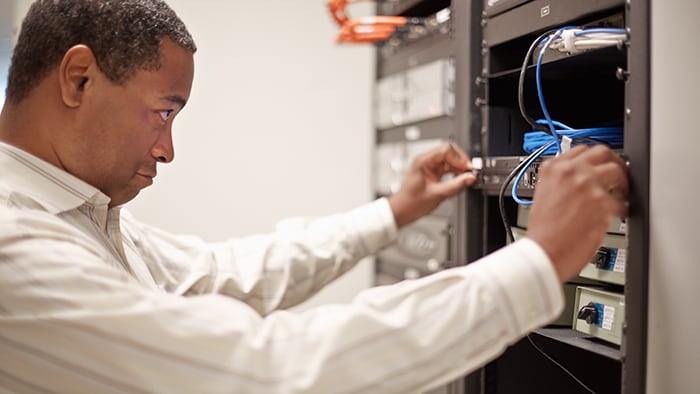
Research [1] indicates that the resource savings unlocked by digital information and communication technology outweigh the increase in footprint caused by the deployment of that technology. But to maximize these savings, we must also focus on building sustainable digital infrastructure, including carbon-free cloud solutions and fully circular design for hardware.
Philips’ approach to digital and the environment
At Philips, we see the digitalization of care as an opportunity to accelerate sustainable development. According to a paper published by J.D Sachs and others, digitalization is one of six key transformations needed to meet the United Nations Sustainable Development Goals. Philips has set ambitious sustainability targets linked to the UN SDGs. These include: ensuring sustainable use of materials and driving the transition to a circular economy; and ensuring sustainable use of energy, reducing emissions, and operating carbon-neutral.
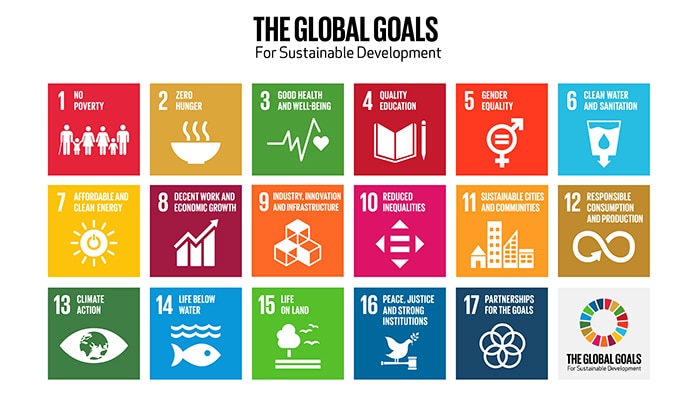
As a purpose-driven health technology company, we are very conscious of our responsibility towards society and of the need to continue to embed sustainability ever deeper in the way we do business – not only in our own operations, but across the value chain, together with our customers and supply partners.
Over a decade ago, we started implementing product requirements for software development, and over the years we realized that we need to approach this topic from a broader perspective.
Our strategy aims to capture the potential of digital to help us realize our sustainability ambitions. This strategy is built around four pillars:
To give a simplified example from another industry, Google Maps running on a smartphone illustrates such a strategy in action: re 1. real-time route optimization means drivers consume less energy getting to their destination; re 2. the way the app is programmed reduces resource consumption, e.g. use of processor, memory, network; re 3. phone manufacturer programs foster responsible end-of-use; re 4. the user can opt for energy-saving mode or select screen brightness/timeout.
If designed well, the digitalization of healthcare can radically improve access and delivery of care, as well as enable much more efficient use of natural resources.
Robert Metzke
Global Head of Sustainability, Philips
Now let’s dive a little deeper, and explore how, at Philips, we are deploying these strategic pillars to deliver healthcare and sustainability benefits for our customers and for consumers.
1. Enabling sustainable development with digital solutions
This is the area where true breakthrough innovation can happen, with significant environmental benefits. To give just one example: Philips eCare Coordinator is a telehealth software platform that helps lower carbon footprint and waste. eCareCoordinator provides tools to remotely track the health of patients at home and collaborate with clinicians to help detect problems before they lead to admissions or readmissions.
Hosted on our cloud-based HealthSuite digital platform, it prevents unnecessary travel, as patients are asked to do pre-assigned health tasks and assessments via the eCareCompanion patient app at home. It also prevents unnecessary hospitalization, in a resource-intensive facility, as patients’ vital signs are remotely monitored, and clinicians identify those most in need of immediate intervention.
A study by Accenture [1] has indicated that 40% of patient visits could be done remotely by 2030. Ultimately, remote interactions like these could potentially reduce the need for physical healthcare facilities, thereby further lowering consumption of materials and energy, as well as travel.
2. Empowering sustainable user behavior
We see tremendous potential to reduce environmental impact by empowering sustainable user behavior. The question is: To what extent, in the digital age, does our behavior affect the environment? The answer, it turns out, is … a lot! Every single search query, every click on a website, every streamed song or video, and every e-mail we send – they all add up to incredible demand for electricity, which results in higher CO2 emissions.
Approximately 50% of all office computers are left on overnight and on weekends. Simply turning computers off at night can reduce annual energy consumption by more than 50%. So each and every one of us can do small things in our daily work that add up to significantly reduce our digital environmental impact. From tiny acorns… And companies and other organizations need to think about enabling more sustainable choices by default and informing users about the environmental impact of their choices and behaviors.
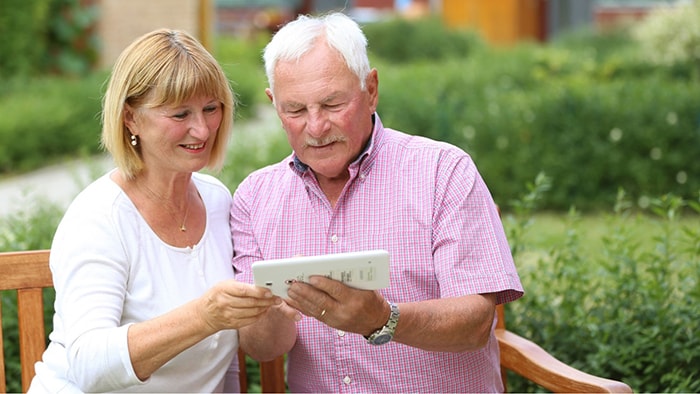
3. How to design software to be energy-/materials-efficient?
Sustainable software design can help reduce the consumption of physical IT hardware and the energy consumption of ICT resources. So, how can we design software in such a way that it minimizes our material and energy footprint?
Over the decades, increasing speed has led to massive parallel computing. Also in the realm of AI, the notion of ‘let the algorithm run’ demands a lot of computing power, which has a material impact. I’ve even heard some software developers ask: ‘To create algorithms that are truly computing-efficient, do we need to go back to the knowledge and capability we had ‘back in the day’, when we had to find a way around the limitations of 32-bit programming?’
Philips PerformanceBridge is one example of software enabling increased hardware utilization – as well as better and more resource-efficient care delivery. This web-based, real-time data platform aggregates data from multiple sources and integrates with the hospital’s image viewer, so that staff get the data they need with context. Operational data is clearly presented, so staff can readily identify outliers and potential improvement opportunities, also when it comes to material/energy usage.
We believe that digitalization can extend access to care to hundreds of millions of people, driving a shift to more sustainable and resilient models of healthcare globally.
Robert Metzke
Global Head of Sustainability, Philips
4. Technology and infrastructure
Cloud computing undoubtedly offers tremendous benefits. When companies move to the cloud, their server utilization can reach ~65%. And while the PUE (Power Usage Effectiveness) of the average data center is 1.7, the cloud industry average is 1.2, meaning more energy is used by computing equipment. In short: Fewer servers required × more efficient servers = less energy consumed!
However, let me also address a common misconception here, namely that the cloud doesn’t take concrete form, that it is somehow ‘free’ – literally ‘out there in the clouds’. This is incorrect: there is of course always hardware somewhere, running the cloud software. Witness the IT server parks we see alongside our highways. This underscores once again the need to take business decisions with an integral perspective on social, environmental and financial impact (‘integrated decision making, true pricing’).
Research by Precedence Research points to 17.8% annual growth of healthcare cloud computing by 2027. By innovating for digital technologies in a sustainable way, we can continue to help our customers transition towards the cloud to lower their operational costs and their environmental impact.
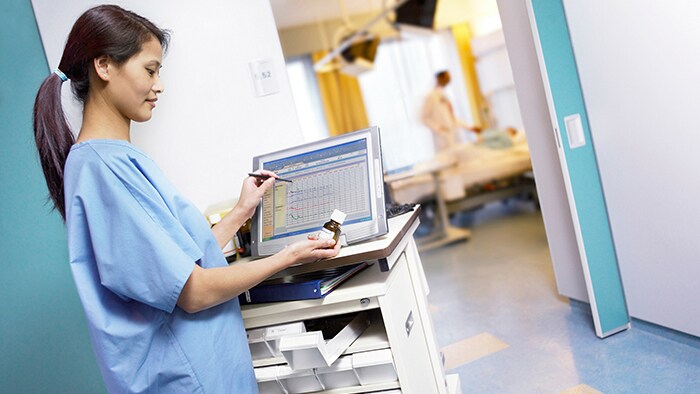
For example, we were able to save IT infrastructure and energy by moving our Philips Electronic Medical Records and Care Management solution to the cloud. This included a 15-ton reduction in CO2 emissions from remote rather than onsite installation. And with the system in the cloud, there is no need to maintain the data center in the institution.
Join us in our endeavors
Digitalization offers tremendous scope to improve the delivery of care – benefiting patients, clinicians and administrators alike. It also has significant potential to reduce the environmental impact of healthcare. However, we can only harness that potential by purposely designing our digital systems to advance sustainable development, and by working together with others in our ecosystem – care providers, practitioners, knowledge partners, and suppliers.
Across industry, we need to team up with experts, e.g. from the world of software architecture, to ensure we make the right decisions and trade-offs for a sustainable future. Two key questions come to mind for these experts:
We are keen to build upon our own experiences and learn from others’ ideas and best practices. In that spirit, I invite you to join the discussion on how to best leverage digitalization to improve healthcare while at the same time accelerating the sustainable use of energy and materials.
1. Accenture #SMARTer2030. (2015). ICT Solutions for 21st Century Challenges.

Share on social media
Topics
Author

Robert Metzke
Philips Global Head of Sustainability Mr. Metzke leads Philips’ activities in Sustainability where he drives the company’s strategy towards innovative, sustainable business models and embedding sustainable and circular ways of working across Philips. In particular, Robert and his team are leading all activities with regards to Philips' environmental responsibility, with a focus on climate action, circular economy and expanding access to healthcare in underserved communities, as part of Philips overall purpose to improve people's health and well-being. Before joining Philips, Mr. Metzke worked at McKinsey & Company as a consultant where he gained 5 years of experience in strategy and innovation in the high-tech, healthcare and public sectors. Mr. Metzke has a background in journalism, science publishing (Science/ AAAS) and academic research (physics). He is married, has three children and lives in the Netherlands.
Follow me on











